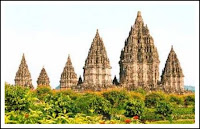 Bali luxury villa : Villa Khayangan Estate
Bali luxury villa : Villa Khayangan Estate Location and Distance: Bukit Pecatu.
Khayangan Estate rests in blissful seclusion upon 1.5 hectares of prime, cliff top land, 170 metres above the rolling surf of the Indian Ocean on the southernmost tip of the island of Bali. The Estate is located near the famous Uluwatu temple, and is immediately adjacent to the Bvlgari Hotel and Resort, overlooking Selonding Beach below. With Bulgari Resort Bali as its prestigious neighbour, Khayangan Estate is only 30 minute drive from Bali International Airport and no more than 45 minute from Kuta and Seminyak. The world-class Bali Golf and Country Club in Nusa Dua is a mere 15 minute drive, and Ubud as Bali centre for fine arts and cultural performances which is about 90 minute drive to the north.
Property size: 15,000 Sqm (1.5 hectare)
Featuring:3 air conditioned bedrooms with ensuite bathroom. Each bedroom is equipped with a mini bar/fridge, safe, satellite TV, stereo system and telephone as well as wi-fi internet access. A private office or work space, with a small, open-air meeting area upstairs - well-equipped with a computer, a multi-function printer, scanner and photocopier, and free Broadband Wifi Internet. Cliff top pavilion beside a Jacuzzi, cliff top spa presents a Vichy shower, hot tub, steam room, massage tables, manicure and pedicure facilities, and a cave-like room for scrubs and water treatments. The infinity-edge, swimming pool of 12m x 5m with canopied sunbeds, tennis court and fully equipped gym.
Service:The Estate is supported by a carefully selected team of highly trained staff including chefs, housekeepers, gardeners and security guards. Khayangan Estate welcomes children of all ages, cots and high chairs can be provided. Baby-sitting services, together with the facilities of a car, a driver, a tour guide and extra staff are also available on request. Security guards are on duty day and night, and there is also a state-of-the-art security alarm system.
Detail Description:Set in a magnificent tropical garden, the Estate comprises of a cluster of traditional, antique, wooden Javanese houses, known as ‘Joglos’, which have been collected by the owners of Khayangan and saved from destruction. The Joglos, with their distinctive funnel-shaped roofs, have been carefully grouped in a semi-circle, echoing the feeling of a traditional Javanese village. Each is blessed with stunning ocean views, while skilful landscaping enhances the ambience and adds to the privacy. The Estate currently provides luxury accommodation for up to six persons in three, self-contained, fully air-conditioned bedrooms, complete with en-suite bathrooms. The focal point of the property is the splendid, hand-carved, century-old Joglo that serves as the main living and dining room, situated beside a 12-metre swimming pool. There is also a business centre, a magnificent cliff top spa complex, known as the Seventh Heaven Spa, a cliff top pavilion, a tennis court and a well-equipped gym. Phase two of the project will introduce three more bedrooms and another pool.
Designed by Cheong Yew Kuan, one of Asia’s leading resort and luxury villa architects, in collaboration with the owners, the architecture blends Javanese tradition with contemporary design and European influences. The buildings incorporate an abundance of recycled teak wood in the form of floorboards, doors and elaborately-carved ‘pondopo’ centrepieces. This is complemented by ironwood shingle roofs and natural stone finishes. Some of the wall panels have been replaced with ceiling to floor glass, giving the buildings a contemporary feel, and allowing more natural light to enter.
The interiors reflect the travels and passions of the owners, who invite guests to share and celebrate the rich heritage of Indonesia through an eclectic collection of Indonesian antiques, artefacts and artwork. At Khayangan, tropical island living meets metropolitan convenience, with state-of-the-art entertainment and communication facilities, together with all the comforts and service you would expect from a luxury boutique hotel. Khayangan Estate takes its name from an ancient Sanskrit word, which could best be translated as ‘Seventh Heaven’.
Khayangan offers numerous relaxation areas, so guests will always find a private spot for peace and quiet. In fact, a large family or group of people could stay at the Estate and still lose each other within its depths. Cool sea breezes and the rhythmic sound of the waves combine to create a close to nature experience.
Living & Dining PavilionSerenaded by the tranquil sound of water, guests will traverse an ornamental pond before entering the living and dining pavilion. This is the largest of the time-honoured teakwood Joglos, created over 100 years ago in Central Java in an area where skilled artisans have developed the art of carving wood to the highest degree of refinement. The Joglo’s most striking feature is its towering core of four intricately and exquisitely carved pillars, showcasing traditional patterns and flowers. Destined to be demolished, this wonderful old building was saved and carefully transplanted to Bali to create the heart and social hub of Khayangan Estate.
This expansive, air-conditioned living and dining area embraces the spectacular view with the incorporation of glass walls on two sides. It has been furnished with large sofas and chairs, a coffee table, a dresser and a rustic dining table for twelve, all custom-made from antique wood. White drapes fall between the central pillars, recycled floorboards are scattered with rugs, and the muted colour theme follows the natural hue of the timber. Antique statues and carvings from the islands of East Nusa Tenggara have been fondly placed in well-lit settings that show them off to their best advantage. Funky wrought iron lamps and lanterns, designed by the owners, channel a soft light by night, creating a romantic ambience. A large, flat screen, satellite TV, DVD and quality sound system is provided for guests’ entertainment. To the rear is a separate, fully-fitted, modern kitchen.
Bedrooms
The master bedroom and guest rooms are housed within three, separate, self-contained Joglos, complete with en-suite bathrooms, wide verandahs, and lovely views of the ocean, the garden, the pool, and the social centre of the Estate. The authentic-style is elegant and enchanting. Each Joglo is air-conditioned and furnished with fitted wardrobes, seating, mirrors and lamps. Each boasts a king-size four-poster bed, built into the beams within the central funnel of the roof. Soft muslin drapes are clutched within simple tiebacks. Paintings, local textiles and ikat cushions create a personal touch. Each bedroom is equipped with a mini bar/fridge, safe, satellite TV, stereo system and telephone as well as wi-fi internet access.
Each luxurious en-suite bathroom is characterised by unique features. Each is equipped with air-conditioning, an all-embracing rainshower, a splendidly appointed bathtub, a toilet, single or twin washbasins, large mirrors, and the thoughtful provision of cushioned bench seats.
Master Bedroom & BathroomThe master bedroom is particularly spacious, and enhanced with the added feature of a bay window and curved window seat, a wall of fitted wardrobes, a desk, an armchair, and a 39-inch flat screen plasma TV with satellite TV.
The sumptuous, air-conditioned en-suite bathroom is a study in symmetry, equipped with large mirrors and ‘his and hers’ washbasins resting upon separate wooden vanity units within two distinct areas. A toilet, together with a bidet, is discretely positioned at one end, while a walk-in rainshower with a pebbled splashback is situated at the other end. The pièce de résistance, however, can be found on the far side of an external glass door. Here, in a beautiful private water-garden, and accessed by stepping stones, a dreamy oversized bathtub, complete with an overhead canopy, appears to be floating in a gin clear ornamental pond. In the far corner of the pond is a ‘floating’, open-sided relaxation pavilion, sheltered by a roof and furnished with a built-in sofa and cushions. The serene picture is completed with an ancient frangipani tree, staghorn and bird’s nest ferns, and a cascading waterfall.
Business CentreThe air-conditioned business centre is a rare, two-storey timber Javanese house that has been transformed into a private office or work space, with a small, open-air meeting area upstairs. This enchanting building represents a bygone era with its raised, wrap-around verandah, and two-tiered roof. It features large glass windows, and has been lovingly furnished with an antique desk, chair, bookshelves, cupboards and a kilim rug. It is well-equipped with a computer, a multi-function printer, scanner and photocopier, and free Broadband Wifi Internet, which can be accessed all over the Estate. An external staircase leads up to the breezy meeting or relaxation area, furnished with a marble-topped table and chairs. Guests’ needs are further considered with the provision of a washroom.
Cliff top PavilionA large open-sided relaxation gazebo, fitted with cushioned seating, rests on the clifftop beside a freshwater Jacuzzi with a chiller. The pool is flanked by a timber deck furnished with canopied chairs.
Seventh Heaven SpaThe architecture of the clifftop spa blends rusticity and glamour. Landscaped into the cliff, with a flat roof supporting a grassy lawn, it is built directly into the rock. The fully-equipped, air-conditioned spa with its glass-fronted curved façade, presents a Vichy shower, hot tub, steam room, massage tables, manicure and pedicure facilities, and a cave-like room for scrubs and water treatments. Overlooking the ocean and the beach, it is also a great spot for meditation. The spa menu offers a full range of massage, beauty treatments and therapies, such as the Ocean Bath, Flower Bath and Aromatherapy Bath, as well as a Cucumber Wrap for sunburnt skin.
Gardens and PoolThe gorgeous landscaped gardens of Khayangan Estate present a very natural feel. Pathways are paved with timber and bordered by dense beds of tall, gently swaying yellow irises. Immaculate lawns are punctuated with palms and other carefully selected native plants and trees, such as bougainvillea, frangipanis and climbers, to provide a balance of fragrance, colour and shade.

The infinity-edge, swimming pool is located in front of the main living and dining area. Shaded by coconut palms and frangipani, and lined with natural stone, the pool appears to flow over the edge of the cliff. The timber pool deck is furnished with canopied sunbeds, while a barbeque and pizza oven is positioned nearby, making alfresco dining easy and fun.
Sports FacilitiesThe tennis court and a fully-equipped gym are located near the entrance to the Estate.
The tennis court has a covered spectator/viewing pavilion with benches and antique “gerobok” (rice storage trunks on wheels) with cushions.
The gymnasium is fully air-conditioned, and includes a full selection of machines, as well as a stereo system, satellite TV, fridge and cold water dispenser.
 Eco Friendly
Eco FriendlyKhayangan Estate incorporates many features designed to reduce its impact on the environment. Bio-degradable waste from the house and garden is collected, mulched and composted for use in the gardens. The garden is irrigated using an underground system that meters water usage on automatic timers. There is also a water purification plant, which produces drinking quality water in all taps. Solar panels have been installed on the roofs for heating water, and ionisers are used instead of chlorine in the swimming pool, which effectively turn the water into pure mineral water using a process approved by NASA. Low-wattage, long life, lighting fixtures keep energy costs down and timers and sensors are also used to avoid excess consumption of power. A waste water recycling system is planned.
Weddings and PartiesKhayangan Estate presents the perfect setting for weddings, parties and other special events. The extensive lawns are also ideal for open-air Balinese dance performances and parties. The catering can be managed by professional caterers who have the world-class expertise to prepare a sumptuous feast in addition to the coordination of decorations, flowers, lighting and entertainment.
 Prambanan Temple is the biggest Hindu Temple in Indonesia. Height of the temple was about 47 meters. The temple was situated about 17 kilometers from East Yogyakarta. Prambanan Temple square was built by the Kings of Sanjaya Dynasty in 9 of century. Prambanan Temple was temples square where the main temple was direct to East. As a whole, the temple was like a mount. A mount like figure in the wayang (puppet play) that symbolizing the Universe.
Prambanan Temple is the biggest Hindu Temple in Indonesia. Height of the temple was about 47 meters. The temple was situated about 17 kilometers from East Yogyakarta. Prambanan Temple square was built by the Kings of Sanjaya Dynasty in 9 of century. Prambanan Temple was temples square where the main temple was direct to East. As a whole, the temple was like a mount. A mount like figure in the wayang (puppet play) that symbolizing the Universe. In front of the temple was situated the temples of Wahana or mount (riding animal) of each Gods. The temples also called as Trimurti Mount. Comprise with Temple of Nandi, Temple of Angkasa, and Temple of Garuda. Nandi is a buffalo that mounted by God Siwa. Angkasa is a swan mounted by God Brahma. And Garuda is an eagle that mounted by God Wisnu.
In front of the temple was situated the temples of Wahana or mount (riding animal) of each Gods. The temples also called as Trimurti Mount. Comprise with Temple of Nandi, Temple of Angkasa, and Temple of Garuda. Nandi is a buffalo that mounted by God Siwa. Angkasa is a swan mounted by God Brahma. And Garuda is an eagle that mounted by God Wisnu.
























































